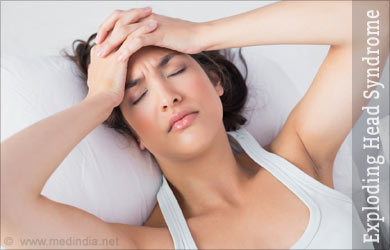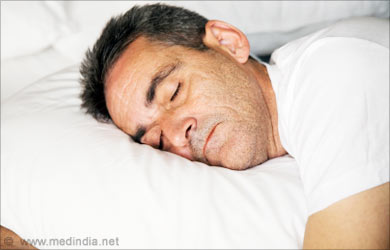- Exploding Head Syndrome – Overview & Facts - (http://yoursleep.aasmnet.org/disorder.aspx?id=33)
- 5 Tips For Battling Exploding Head Syndrome - (http://www.huffingtonpost.com/2011/12/23/exploding-head-syndrome-tips_n_1167768.html)
- ‘Exploding head syndrome’ a real, overlooked sleep disorder - (https://news.wsu.edu/2014/05/06/exploding-head-syndrome-a-real-overlooked-sleep-disorder/#.u44rarwk__q)
About
A small percentage of people experience a loud popping sound just before drifting into deep sleep or when coming out of one. The sound resembles a gun shot, the sound of an explosion, or any loud disturbing sound that originates in the head or the ears. The sound generally lasts for only a few seconds. Such a condition is called the exploding head syndrome (EHS).
Although it was described nearly 138 years ago, Armstrong-Jones first recorded this condition in 1920. Patients described the symptom as “something that exploded in my head”. Exploding head syndrome is a benign sleep disorder or parasomnia, with no known causes. The syndrome is classified under the sleep-related myoclonus group of sleep disorders.

Although the condition is benign, patients suffering from EHS experience the fear of the recurrence of loud sounds, sweating, paralysis of sleep, and breathing difficulty. Patients suffering migraine are prone to increased episodes of migraine due to the stress and fear of the recurrence of loud sounds. The unique characteristic of EHS that distinguishes it from other sleep disorders is that it does not trigger headaches, pain, or rupture of internal organs. Patients tend to experience light flashes or sudden muscle jerks during such episodes. Women are more prone to EHS compared to men. Adults above the age of 50 and children around the age of 10 years are also prone to EHS. The average age of occurrence is 58 years. Individuals who experience EHS may suffer either large number of episodes in one night for many nights or experience 2 to 4 episodes before a long or complete remission. Individuals with EHS tend to suffer from drowsiness during the day due to disturbed sleep. The prevalence of exploding head syndrome is variable and is not known.
Causes of Exploding head syndrome
Currently, the exact cause of EHS is unknown. Individuals are more prone to this condition when they experience fatigue or high stress in their lives.
Certain other causes of Exploding head syndrome are:
- Movement of the Eustachian tube
- Seizure of the temporal lobe complex

- Movement of the component of the middle ear
- Sudden withdrawal of drugs (eg, certain inhibitors of serotonin uptake, benzodiazepines)
Symptoms of Exploding head syndrome
The common symptoms of exploding head syndrome are:
- The presence of a loud startling sound such as an explosion or the clashing of cymbals, or a gun shot, soon after drifting off to sleep or when waking up.
- The startling sound frightens the individual causing fear, sweating, or rapid breathing.
- The startling sound is free of pain in the head.
- There is drowsiness during the day.

Diagnosis of Exploding head syndrome
The diagnosis of EHS varies from migraines, different types of nocturnal headache conditions (eg, cluster, hypnic, thunderclap), startled sleep, and nightmares. Obstructive sleep apnea is another diagnosis of EHS. The disturbing sounds occur in individuals during the stage of non-rapid eye movement sleep (non-REM), when individuals are in transition from wakefulness to deep sleep or vice versa. A research study also observed that such attacks occurred soon after snoring.
Individuals who suffer from EHS episodes should maintain a diary of their sleep patterns. This enables the doctor to understand the frequency of occurrence of the episodes. The doctor may also deduce the effect of other syndromes based on the pattern of the frequency of occurrence.
Doctors tend to perform an overnight sleep study or polysomnogram of an individual who is affected by frequent episodes of EHS and are unable to sleep. The polysomnogram records heart beat, breathing rate, movement of limbs (arms, legs), and brain signals to confirm the condition as EHS or the result of another disorder.
Treatment of Exploding head syndrome
Currently, there are no treatment options for EHS. Most of the treatment procedures are palliative procedures to reduce the frequency of EHS.
Some of the treatment suggestions for EHS are as follows:
Healthy, balanced diet: Individuals are encouraged to eat a well-balanced diet. Vegetables and fruits provide a rich source of minerals and vitamins that aid in relieving stress. This leads to a restful night.

Reassurance: A patient suffering from EHS should be reassured that the condition is not serious and physically debilitating. This is the best and often most reliable procedure to reduce a patient’s anxiety related to EHS.
Relaxation: Individuals are encouraged to relax in order to reduce the frequency of occurrence of EHS. Relaxing also reduces stress and anxiety that set in due to EHS.
Minimum of 6 hours of sleep: It is a good idea to obtain a minimum of 6 hours of sleep during the night. Individuals, who sleep for less than 6 hours, suffer from sleep-related disorders or myoclonus.

Minimize stress: Individuals are faced with different forms of stress everyday. Hence, it is preferable to keep aside time for leisure activities such as relaxing with family and friends, spending some recreation time (eg, taking a walk, reading, listening to music, yoga, etc) before going to sleep. The body is thus relieved of stress and is relaxed before falling asleep.
Consult a doctor: When the frequency of interruptions increases in individuals, who are unable to get a good night’s sleep, they should consult a doctor. Although there are no fixed medications for EHS, certain prescription medications are known to be effective (eg, flunarizine - 10 mg/day {unavailable in the United States of America}, clomipramine {tricyclic antidepressant} - 50mg at night, imipramine - 10 mg and alprazolam - 0.25 mg at night, topiramate - 200 mg per day, nifedipine {calcium channel blocker} - 90 mg/day). Studies have shown clomipramine to be moderately effective in treating EHS.






